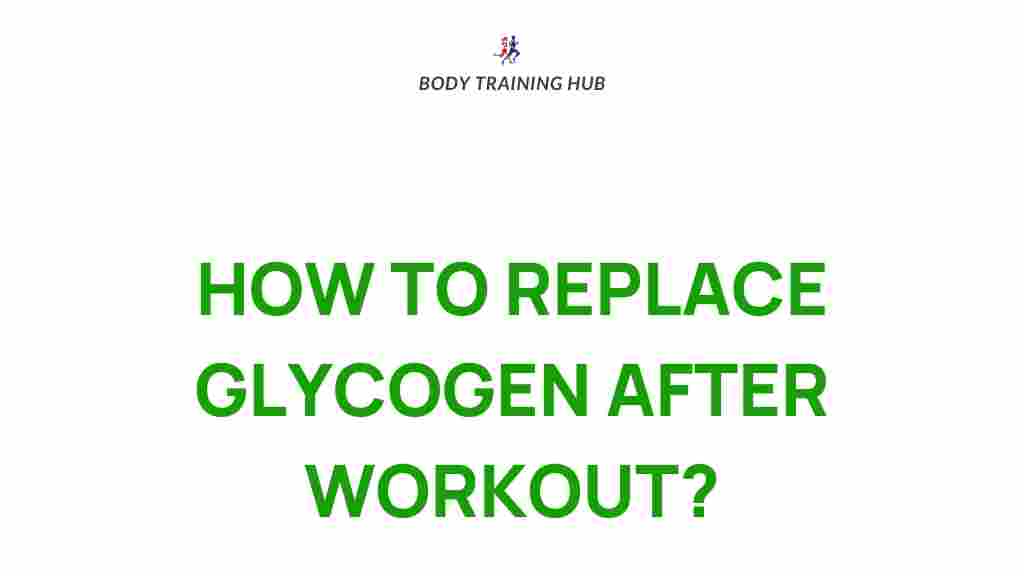Understanding Glycogen and Its Role in Recovery
Glycogen is the primary energy storage molecule in your muscles and liver, made up of glucose molecules. During intense physical activity, your body relies heavily on glycogen to fuel your muscles. After a workout, your glycogen stores are depleted, and replenishing them is crucial for optimal recovery and performance.
In this guide, we’ll delve into the science of glycogen replenishment, explore best practices, and provide actionable tips to help you recover like a pro. Whether you’re a seasoned athlete or a fitness enthusiast, understanding glycogen is key to enhancing your training outcomes.
Why Glycogen Replenishment Matters
Post-workout glycogen replenishment is essential for several reasons:
- Muscle recovery: Replenishing glycogen helps repair muscle fibers and reduce soreness.
- Energy restoration: Adequate glycogen levels prepare you for your next workout.
- Improved performance: Consistent replenishment supports long-term gains and endurance.
Neglecting glycogen restoration can lead to fatigue, diminished performance, and a prolonged recovery period.
The Science of Glycogen Replenishment
After exercise, your body is primed to restore glycogen, thanks to increased insulin sensitivity and enhanced enzyme activity. To optimize glycogen replenishment, it’s essential to consume the right nutrients in the appropriate time frame.
Timing Is Everything
The first 30 minutes to two hours post-workout is often referred to as the “glycogen window.” During this period, your muscles are most efficient at absorbing glucose and converting it into glycogen. Missing this window can slow down the replenishment process.
Macronutrients for Glycogen Synthesis
- Carbohydrates: Consuming carbohydrate-rich foods post-exercise is the cornerstone of glycogen replenishment. Opt for fast-digesting carbs like fruits, white rice, or sports drinks for quicker absorption.
- Proteins: Pairing carbs with proteins enhances glycogen synthesis and promotes muscle repair. Aim for a ratio of 3:1 or 4:1 carbs to protein for optimal results.
- Fats: While beneficial for overall health, fats should be limited immediately post-workout to avoid slowing digestion.
Step-by-Step Guide to Glycogen Replenishment
Step 1: Prioritize High-Glycemic Index Foods
Foods with a high glycemic index (GI) provide a quick spike in blood sugar, making them ideal for immediate post-workout consumption. Examples include:
- Bananas
- White bread
- Potatoes
- Dextrose-based supplements
Step 2: Hydrate Adequately
Hydration plays a critical role in glycogen synthesis. Water helps transport glucose to muscles, while electrolyte drinks can restore lost minerals, enhancing overall recovery.
Step 3: Consume a Balanced Post-Workout Meal
Within two hours of your workout, eat a balanced meal containing carbs, proteins, and minimal fats. A simple example could be grilled chicken with sweet potatoes and steamed vegetables.
Step 4: Use Supplements Wisely
If whole foods are not immediately accessible, consider high-quality supplements. Options include:
- Protein shakes with added carbohydrates
- Commercial recovery drinks
- Glycogen-replenishing gels or powders
Common Mistakes in Glycogen Replenishment
Skipping Post-Workout Nutrition
Many people overlook the importance of eating after exercise, delaying recovery and impairing performance. Always plan your post-workout nutrition ahead of time.
Overemphasizing Protein
While protein is vital, prioritizing it at the expense of carbohydrates can hinder glycogen restoration. Balance is key.
Underestimating Hydration
Neglecting hydration can compromise glycogen storage and overall recovery. Always replenish fluids lost during exercise.
Monitoring Your Glycogen Levels
Although it’s challenging to measure glycogen levels directly, you can gauge them through performance and recovery markers. If you feel sluggish or experience prolonged soreness, your glycogen stores may not be fully replenished.
Tracking your diet and post-workout habits with apps or fitness journals can help you stay consistent. For more advanced strategies, consult a nutritionist or a performance coach for personalized advice. Explore our complete guide to recovery nutrition for additional insights.
External Factors Affecting Glycogen Replenishment
Intensity and Duration of Exercise
The more intense and prolonged your workout, the more glycogen you’ll need to replenish. Endurance athletes often require higher carbohydrate intake compared to strength trainers.
Individual Metabolic Rates
Metabolic differences between individuals influence how quickly glycogen is restored. Factors such as age, genetics, and muscle mass play significant roles.
Dietary Choices
A well-rounded diet supports glycogen replenishment. Avoid highly processed foods and focus on nutrient-dense options for better results. For a deeper dive, check out this research study on glycogen metabolism.
Troubleshooting Glycogen Replenishment Issues
If you’re struggling to recover effectively, consider the following troubleshooting tips:
- Assess your carb intake: Ensure you’re consuming enough carbohydrates to meet your energy needs.
- Revisit your timing: Align your meals with the glycogen window for maximum benefits.
- Seek professional advice: Consult a dietitian to evaluate and optimize your nutrition plan.
Conclusion
Post-workout glycogen replenishment is a vital component of athletic recovery and performance. By understanding the science, timing your nutrition, and making informed dietary choices, you can maximize your recovery and prepare your body for future workouts.
Start implementing these strategies today to unlock your full potential. Consistency is the key, and with the right approach, you’ll notice significant improvements in both recovery and performance.
This article is in the category Strength & Recovery and created by BodyTraining Team
